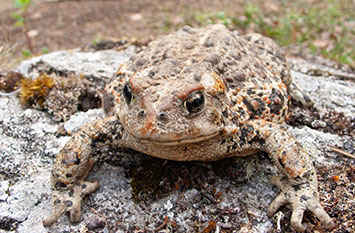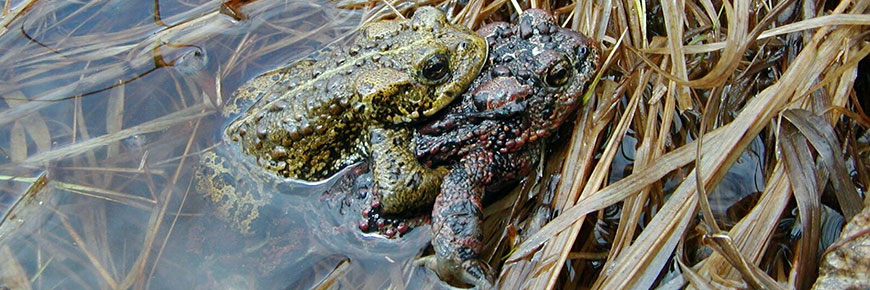
Western toad
Jasper National Park
Quick facts
Eats beetles, ants, worms, and slugs
Weighs about as much as a deck of cards (males ~ 80g, females ~ 115g)
Hibernates underground below the frost line, sometimes under squirrel middens or in abandoned beaver lodges
Lays eggs generally only once in their lifetime, but female western toads can lay up to 16 500 eggs
Lifespan about 6-8 years in Alberta
SARA status: Special concern (Calling population) (2012)

Western toads (Anaxyrus boreas) are warty, with light and dark splotches, and a cream-coloured stripe running along their backs up to their heads. The toads make calls (sounds) during breeding season, which happens in Jasper National Park from mid-April to mid-May.
Where they live
Western toads have an extensive range throughout western North America, including southern areas of the Yukon Territory, most of British Columbia and western Alberta. These toads can be found in valley and subalpine forests and meadows, generally near water. Western toads are one of only a few amphibians that inhabit alpine areas up to an elevation of 2 300 metres. The toads hibernate from September to April, burrowing underground or in abandoned rodent tunnels or beaver lodges.

Why they are at risk
Amphibian chytrid fungus
This fungus, which causes a skin infection in amphibians, has been linked to a global decline in the populations of many species. Western toads are particularly sensitive to this infection.
Habitat disturbance
Western toads migrate to and from water bodies where they breed and hibernate. Roads are a dangerous obstacle in their migration.
Western toads gather in large numbers during all life stages, including communal breeding sites and migrations. This means that large numbers of toads can be affected by habitat degradation or fragmentation.
How we are helping
Protecting habitat
We assess projects around riparian areas and water bodies to ensure impacts from construction and human disturbance are minimized or mitigated.
Monitoring populations
We conduct surveys every three years to assess the health and monitor the distribution of amphibian populations.
Preventing the spread of aquatic invasive species
If you are bringing water equipment, such as angling gear, canoes, paddleboards or diving equipment to Jasper National Park, you are required to clean, drain and dry your equipment before entering a new water body.
All construction equipment has to go through a disinfection process before it can be used in the park.

- Date modified :